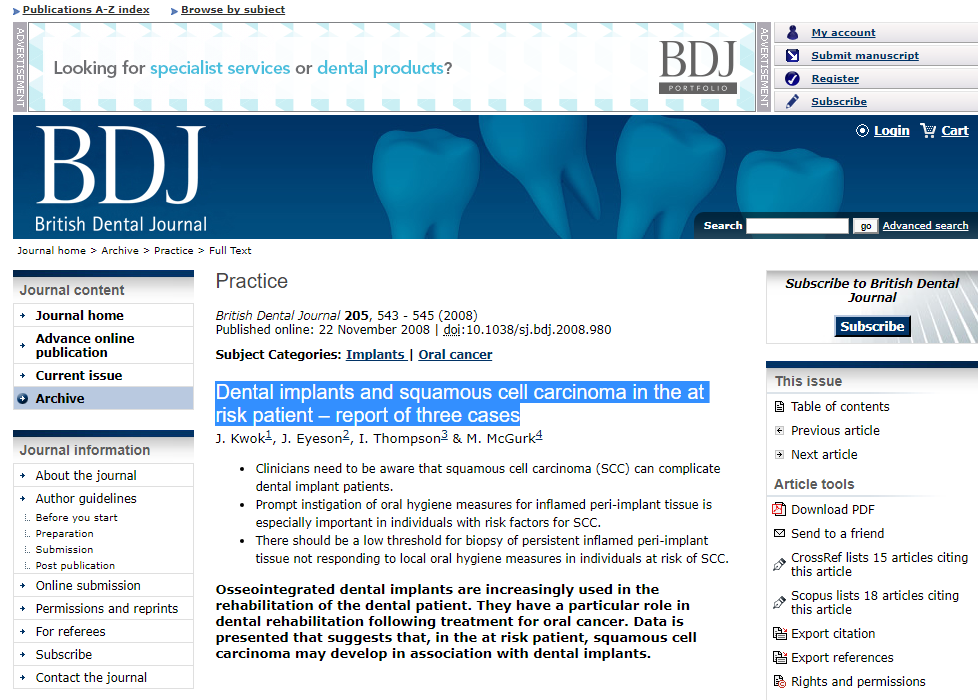Dental implants and squamous cell carcinoma in the at risk patient – report of three cases
British Dental Journal 205, 543 - 545 (2008)
Published online: 22 November 2008 | doi:10.1038/sj.bdj.2008.980
Subject Categories: Implants | Oral cancer
Dental implants and squamous cell carcinoma in the at risk patient – report of three cases
J. Kwok1, J. Eyeson2, I. Thompson3 & M. McGurk4
- Clinicians need to be aware that squamous cell carcinoma (SCC) can complicate dental implant patients.
- Prompt instigation of oral hygiene measures for inflamed peri-implant tissue is especially important in individuals with risk factors for SCC.
- There should be a low threshold for biopsy of persistent inflamed peri-implant tissue not responding to local oral hygiene measures in individuals at risk of SCC.
Abstract
Osseointegrated dental implants are increasingly used in the rehabilitation of the dental patient. They have a particular role in dental rehabilitation following treatment for oral cancer. Data is presented that suggests that, in the at risk patient, squamous cell carcinoma may develop in association with dental implants.
Introduction
Dental implants have revolutionised the practise of dentistry and are now an integral part of modern clinical practice. In addition, implant-based restorations (dentures, obturators or crowns) have a beneficial role in the dental rehabilitation of patients treated surgically for oral cancer.1, 2
In such circumstances, the tissues are frequently distorted, scarred and insensate, which makes it almost impossible to retain a traditional lower denture. Quality of life measures show that patient well-being is significantly improved by restoring dental function.
The pathogenesis of oral squamous cell carcinoma (SCC) is well established. In humans it is linked largely to lifestyle habits, in particular the excess consumption of alcohol and tobacco. Pre-malignant lesions are well characterised in the form of some leukoplakias and erythroplakia. Occasionally patients with lichen planus can develop the disease.3 The disease can also evolve de novo in the elderly, without apparent risk factors apart from the biological effects of age.
In the animal model, squamous cell carcinoma can be reliably induced by a two stage process. The first involves priming the oral mucosa with a carcinogenic agent. After a period of delay this primed mucosa can be induced to develop SCC by a seemingly innocent 'initiating' factor such as trauma or irritation. In this context, dental implants lack an epithelial attachment at the cervical margin and this is a recognised source of persistent irritation which normally has no serious implications apart from for those predisposing to peri-implantitis.
This paper reports three patients with implant-based restorations who subsequently developed SCC in the peri-implant tissue. Two cancers arose de novo. The implications are discussed.

http://www.nature.com/bdj/journal/v205/n10/full/sj.bdj.2008.980.html
